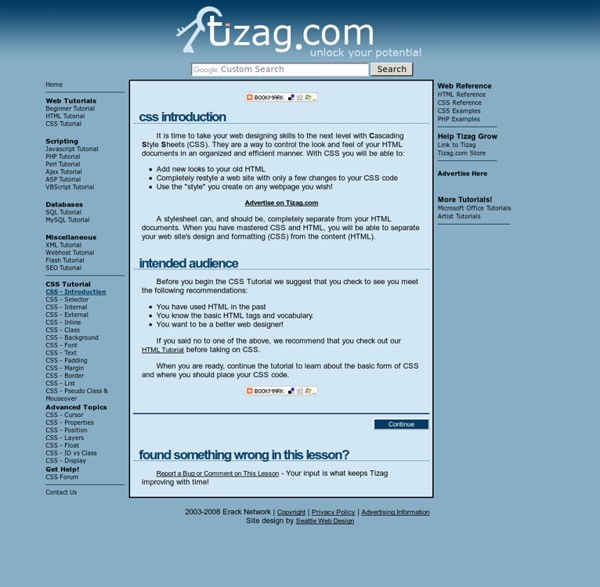Learn to Code « Heterogenous Mixture
A lot of people have asked me for advice on learning to code. What should I learn first? How long will it take? How can I get a job as a programmer? The answer to most of these questions is “it depends.”
CSS Guide
What Is CSS? CSS (cascading stylesheets) is a simple mechanism for controlling the style of a web document without compromising its structure. By separating visual design elements (fonts, colors, margins, and so on) from the structural logic of a web page, CSS gives designers the control they crave without sacrificing the integrity of the data, thus maintaining its usability in multiple environments. In addition, defining typographic design and page layout from within a single, distinct block of code — without having to resort to image maps, <font> tags, tables, and spacer GIFs — allows for faster downloads, streamlined site maintenance, and instantaneous global control of design attributes across multiple pages. Client-side support for the various CSS properties is uneven, even among browsers that support stylesheets.
Learn PHP - PHP Tutorial - Learn PHP Code
PHP can be a powerful tool on your web site and learning it isn't as hard as you might think. Using our informative tutorials, even a beginner with no programming experience can start learning PHP and putting it to use right away. Learn PHP in 8 WeeksIn just a few minutes ever week, you can learn all the basics of PHP. This course is broken down into eight short lessons. In just eight weeks you will have a firm grasp of all the basic PHP concepts. How to use Arrays in PHPHow to setup and access an array and it's elements using PHP.
CSS Tutorial
This free CSS Tutorial is for beginners. It teaches you CSS from the ground up - starting with the basics. It is assumed that you are familiar with HTML. If not, read the (free) HTML Tutorial first, then come back to this tutorial.
Free HTML Tutorial - Learning to Code HTML
Home >> Building Your Website Customizable HTML / CSS Web Templates Download these HTML / CSS templates and learn how to edit them to fit your needs.
Mozilla Developer Network: CSS
Cascading Style Sheets, most of the time abbreviated as CSS, is a stylesheet language used to describe the presentation of a document written in HTML or XML (including various XML languages like SVG or XHTML. CSS describes how the structured element must be rendered on screen, on paper, in speech, or on other media. CSS is one of the core languages of the open web and has a standardized W3C specification. Developed in levels, CSS1 is now obsolete, CSS2.1 a recommendation and CSS3, now split into smaller modules, is progressing on the standard track. CSS Reference An exhaustive reference for seasoned Web developers describing every property and concept of CSS. CSS Tutorial A step-by-step introduction to help complete beginners get started.
4 Free Ways to Learn to Code Online
The Web Development Series is supported by Rackspace, the better way to do hosting. Learn more about Rackspace's hosting solutions here. Learning to code is something every tech-minded person should try at least once — and the wealth of online courses, many of which are free or surprisingly inexpensive, make learning about programming easier than ever. If you're thinking of picking up C++, Ruby on Rails, Python or Java, these online options might be a good way to test the waters of programming before you fully invest your time and money in formal training or certifications.
CSS-Tricks
5 Great Resources To Learn How To Code
However, more often than not, there seems to be a problem of actually finding good content online that can teach you to code. Experimenting with a language can only get you so far. To master it, you need to have proper guidance from people who actually know what they are talking about. So where can you find expert guidance without shelling out a fortune for it?
Scriptplayground: Learn how to code from the ground up



